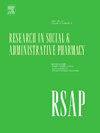直接口服抗凝药的药房配药与电子监测数据之间的一致性 - MAAESTRO 研究的二次分析。
IF 3.7
3区 医学
Q1 PUBLIC, ENVIRONMENTAL & OCCUPATIONAL HEALTH
Research in Social & Administrative Pharmacy
Pub Date : 2024-08-26
DOI:10.1016/j.sapharm.2024.08.090
引用次数: 0
摘要
背景:直接口服抗凝剂是心房颤动中风患者的首选治疗方法。药房配药数据是识别次优用药依从性的实用方法:本研究使用瑞士巴塞尔 MAAESTRO 研究(2018-2022 年)中 130 名患者的数据,调查药房配药数据是否能反映现实生活中的依从性行为:这项对 MAAESTRO 研究(Dietrich,2024 年)的二次数据分析包括了 12 个月内具有电子监测(EM)和配药数据的患者。至少有两次补药的患者被纳入分析范围。我们采用德尔塔 T 法(Baumgartner,2022 年)将续药系列分为三种依从性模式:全部按时续药、不规则续药、末端间隙≥10 天。EM 依从性通过 "服用依从性 "和 "缺失天数"(24 小时未服用)进行评估。我们分析了:i) 所有配药数据("所有笔芯");ii) 独立于 MAAESTRO 阶段的所有数据("所有阶段");iii) 最后两次配药数据("最后一次");iv) MAAESTRO 阶段中与最后一次笔芯日期相匹配的 EM 数据("匹配")。使用斯皮尔曼相关性和费雪精确检验法检验再充药模式与依从性之间的关联:对 50 名患者(平均年龄为 76.4 ± 9.1 岁,56.0% 为男性)的数据进行了分析,其中包括 252 次补药,每位患者补药次数的中位数为 4 次。补药模式为:全部按时补药(40.0%)、补药不规律(36.0%)和补药间隔大于 10 天(24.0%)。平均服药依从性为 89.3 ± 13.7%。EM数据显示,82.0%的患者缺失了服药天数,61.0%的患者有不规则的再服药模式。匹配的服药依从性与 Delta T 的所有笔芯(p = 0.034)和最后一次笔芯(p = 0.013)有中度相关性:结论:使用 Delta T 方法处理的配药数据与 EM 数据有一定的相关性。最后两次再充装的 Delta T 值显示了估计不规则依从性的前景,这表明在药学实践中进行有针对性的干预是有潜力的。本文章由计算机程序翻译,如有差异,请以英文原文为准。
Concordance between pharmacy dispensing and electronic monitoring data of direct oral anticoagulants - A secondary analysis of the MAAESTRO study
Background
Direct oral anticoagulants are the preferred treatment for stroke patients with atrial fibrillation. Pharmacy dispensing data represent a practical method to identify suboptimal medication adherence.
Objective
This study investigates whether pharmacy dispensing data are indicative of real-life adherence behavior, using data from 130 patients in the MAAESTRO study (2018–2022) in Basel, Switzerland.
Methods
This secondary data analysis of the MAAESTRO study (Dietrich, 2024) included patients with electronic monitoring (EM) and dispensing data for 12 months. Patients with at least two refills were included in the analysis.
We categorized refill series into three adherence patterns using the Delta T method (Baumgartner, 2022): all refills on time, erratic refills, end-gaps ≥10 days. EM-adherence was assessed through “taking adherence” and “missing days” (24h without intake). We analyzed: i) all dispensing data (“all refills”); ii) all data independently of the MAAESTRO phase (“all phases”); iii) the last two dispensing data (“last”), and iv) EM data from the MAAESTRO phase that match the date of the last refill (“matched”). Associations between refill patterns and adherence were examined using Spearman correlation and Fisher's exact test.
Results
Data analyzed from 50 patients (mean age 76.4 ± 9.1 years, 56.0 % male) included 252 refills with a median of 4 refills per patient. Refill patterns were: all refills on time (40.0 %), erratic refills (36.0 %), and end-gaps >10 days (24.0 %). Mean taking adherence was 89.3 ± 13.7 %. EM data revealed missing days in 82.0 % of patients, with 61.0 % having irregular refill patterns. Matched taking adherence was moderately associated with Delta T over all refills (p = 0.034) and the last refill (p = 0.013).
Conclusions
Dispensing data processed with the Delta T method correlate moderately with EM data. The Delta T value for the last two refills shows promise for estimating irregular adherence, suggesting potential for targeted interventions in pharmacy practice.
求助全文
通过发布文献求助,成功后即可免费获取论文全文。
去求助
来源期刊

Research in Social & Administrative Pharmacy
PUBLIC, ENVIRONMENTAL & OCCUPATIONAL HEALTH-
CiteScore
7.20
自引率
10.30%
发文量
225
审稿时长
47 days
期刊介绍:
Research in Social and Administrative Pharmacy (RSAP) is a quarterly publication featuring original scientific reports and comprehensive review articles in the social and administrative pharmaceutical sciences. Topics of interest include outcomes evaluation of products, programs, or services; pharmacoepidemiology; medication adherence; direct-to-consumer advertising of prescription medications; disease state management; health systems reform; drug marketing; medication distribution systems such as e-prescribing; web-based pharmaceutical/medical services; drug commerce and re-importation; and health professions workforce issues.
 求助内容:
求助内容: 应助结果提醒方式:
应助结果提醒方式:


